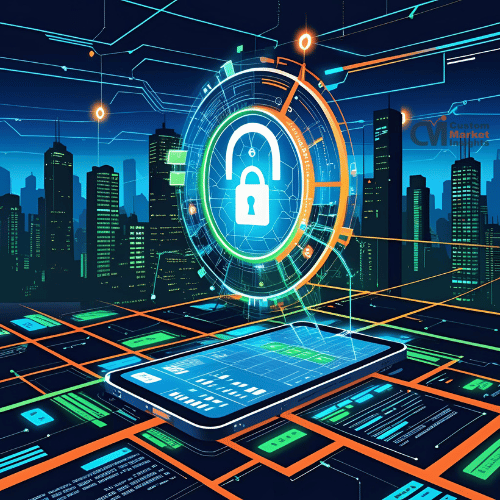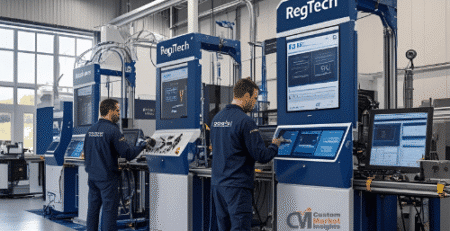The financial sector is one of the most profitable for cybercriminals to attack. Digital banking, mobile payment systems, and online investment platforms have all grown quickly, which has led to a big rise in the amount of sensitive client data that is stored and moved online. More and more financial institutions are using artificial intelligence (AI) to create advanced cybersecurity solutions. This is because the threat landscape is always changing.
CMI’s recent study shows that AI-driven cybersecurity is becoming more and more crucial in a world that is growing more and more connected. This is to secure digital assets and preserve customers’ trust.
More and more threats to financial services are coming from cyberspace.
The cybersecurity landscape for financial companies is both complicated and often changing. Banks and fintech companies have to cope with many different ways that people might attack them. Some of these attack types are phishing scams, ransomware attacks, identity theft, and threats from those who work for the company. If there is a data breach in the financial sector, it may be very bad for the company’s brand and the amount of money lost.
In March 2025, a major European bank said that a sophisticated cyberattack had compromised over a million customer records. These developments led to a new need for defenses driven by artificial intelligence. “The financial sector is being attacked all the time. A CMI Cybersecurity Analyst says that artificial intelligence offers a solution that is both flexible and scalable, and it adapts faster than any other cybersecurity technology.
The Job of AI as the First Line of Defense:
Artificial intelligence is transforming how we protect ourselves online since it can help us find threats in real time, automate tasks, and make predictions. Artificial intelligence systems can look at millions of data points across networks, applications, and endpoints to find unusual activities that can mean a security breach. Artificial intelligence models adapt and grow with each attack, which makes them more resilient over time. This approach is different from rules-based systems, which stay the same over time.
According to CMI’s market study, companies that employ artificial intelligence (AI) for cybersecurity uncover breaches forty percent faster than those that simply use traditional methods. In the event of an incident, this speed is important for limiting damage and speeding up the reaction time.
Behavioral Analytics: Stopping Attacks Before They Happen
AI-powered behavioral analytics are a big step forward in finding risks that can be avoided. Artificial intelligence may find strange behavior like fast money transfers, attempts to get illegal access, or strange login times by learning how people and systems usually perform. These early warning signs help IT teams find and fix problems before they get worse.
JPMorgan Chase is a shining example of a company that uses AI behavioral monitoring to find and stop efforts at insider fraud. These AI models are crucial for keeping people safe from threats from inside and outside. As banks and other financial institutions deal with more and more customers, these risks are getting more complicated.
Using AI to automate incident response
AI not only finds possible threats, but it also makes automated incident response much easier. Machine learning models can get rid of malware, sort warnings by importance, and do things like isolate affected machines. This automation lets security staff focus on making more difficult choices instead of getting distracted by simple alarms.
Banks like Standard Chartered and Wells Fargo use AI-powered Security Orchestration, Automation, and Response (SOAR) solutions to make their incident response processes more efficient. By cutting reaction time from hours to minutes, these platforms may greatly reduce the amount of damage done and make sure that security standards are followed throughout the world.
Ensuring the privacy of information and safeguarding online identities are crucial.
Two of the biggest problems in the financial services business are digital identity theft and data security breaches. AI is making identity verification better by using biometric authentication, facial recognition, and multi-factor risk assessment models. This sophisticated technology can spot fake documents, attempts to steal identities, and strange behavior during the onboarding process or transactions.
According to CMI’s 2025 Data Protection Trends Analysis, by 2027, more than 65% of Tier-1 institutions will utilize AI-enhanced identity verification solutions. A Senior Analyst at CMI says that banks and other financial institutions may use artificial intelligence to offer safe and simple services to customers while following strict privacy rules.
Following the rules, keeping everything in order, and responsibly using AI:
AI makes cybersecurity better, but it also makes it harder to hold individuals accountable and be open about what they do. AI models must follow the regulations that safeguard data in their country and throughout the world. The General Data Protection Regulation (GDPR) and the California Consumer Privacy Act (CCPA) in the US, as well as the Reserve Bank of India’s cybersecurity architecture in India, are two examples.
People are becoming more and more cautious about the ethical use of AI, especially when it comes to collecting data, getting consent, and algorithmic bias. Regulators are more and more worried about how AI is used. They want financial companies to use explainable AI (XAI) and make sure that people are still involved in making decisions that are made automatically. CMI stresses the need for creating full governance mechanisms to make sure that AI is used correctly in cybersecurity.
Different views on the AI-powered cybersecurity business:
It looks like AI will be a big part of keeping financial data safe in the future. CMI’s 2024 Cybersecurity Market Forecast says that the market for AI-driven cybersecurity in the financial services industry is expected to increase at a compound annual growth rate (CAGR) of 26% from 2024 to 2031. The rise is being fueled by more security dangers, more rules, and a move toward banks that put digital technology first.
Banks and IT businesses are working together to build the next generation of cybersecurity tools. In early 2025, IBM and a group of Asian banks formed a partnership to provide AI-based security solutions that work with digital banking platforms. Citibank’s artificial intelligence department is also working on predictive cybersecurity algorithms that can replicate attacks and fix problems before they happen.
About the Future: A Safe and Intelligent Future for Money:
Combining AI with cybersecurity gives banks and other financial firms a strategic edge. Such an effort is necessary for both business and technological reasons. As the sector goes more digital, proactive security powered by AI will become more and more important for building trust and resilience. Banks that put AI-powered security measures first will not only be able to stop breaches, but they will also be able to build stronger relationships with their customers by being open and honest.
Conclusion:
Finally, the main purpose of AI in financial cybersecurity is to provide customers more control. Banks can keep ahead of hazards, customers can trade with confidence, and regulators can make sure that new digital technologies are safe. If we use AI wisely, the future will be safer and smarter for everyone.
Connect with our Experts


